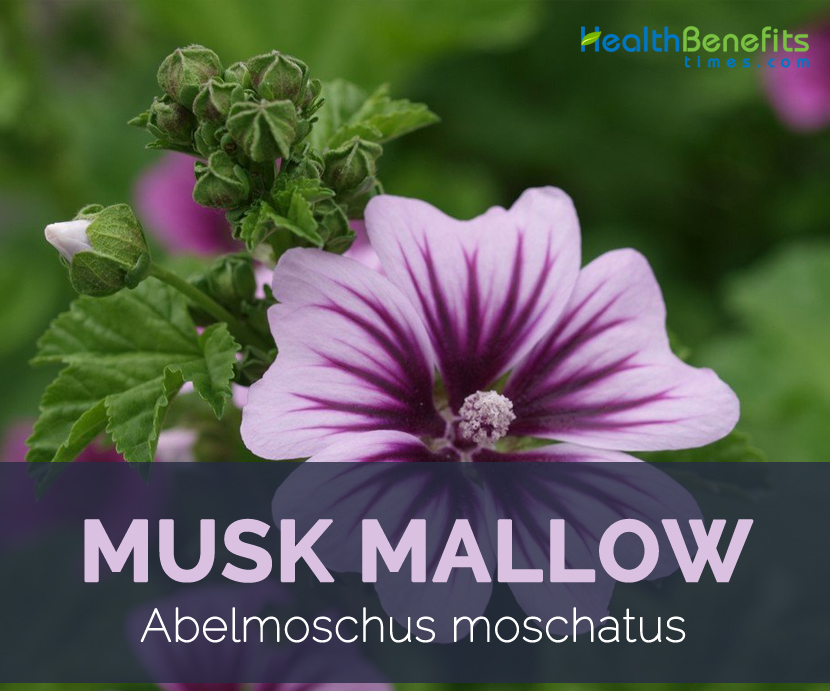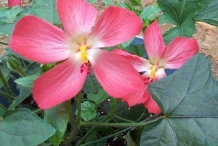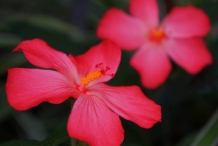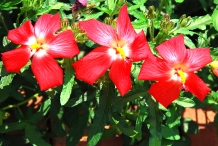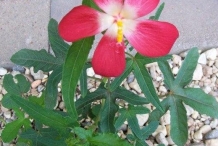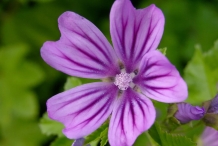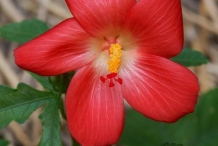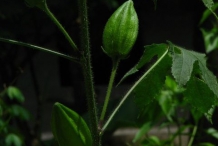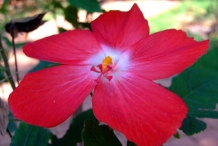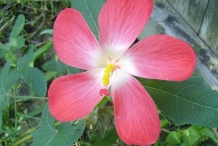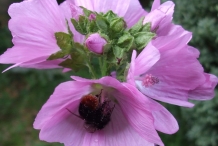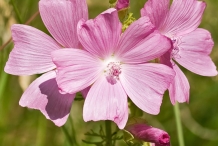| Musk mallow Quick Facts | |
|---|---|
| Name: | Musk mallow |
| Scientific Name: | Abelmoschus moschatus |
| Origin | Tropical Asia |
| Shapes | Long, lanceolate in form of capsule |
| Taste | No Taste |
| Health benefits | Diabetes, Constipation, Dysuria |
| Name | Musk mallow |
|---|---|
| Scientific Name | Abelmoschus moschatus |
| Native | Tropical Asia |
| Name in Other Languages | English: Ambrette plant, Fautia, gandapura, Kasturi, Musk, musk mallow, Musk mellow, musk okra, musk seed, Muskmallow, Muskseed, okra, rose of Sharon, Vegetable musk plant, tropical jewel-hibiscus Arabic: Abu-el-misk, abu-l-mosk, habb el mosk, Hab-Ul-Mishk Assamese: Gorokhiakarai. Chamorro: Kamang, caamung Chinese: Shān yóu má (山油麻), Fúróng má ( 芙蓉麻), Yě miánhuā (野棉花), Yě yóu má( 野油麻), Huáng kuí (黄葵) Fijian: Ambretta semi, Aukiki, O’e’e, Okeoke, Vakeke, Wakeke, Wakewake, Wakiwaki French: Algalia, Almizcle vegetal, Ambrette, gombo musqué, graine de musc, ketmie des marais, ketmie musquée, mauve musquée German: Ambramalve, Bisameibisch, Muskateller-Bisameibisch, Muskateller-Eibisch, Moschus-Malve Indonesian: Gandapura, kasturi Italian: Ambretta, Abelmosco, Fior muschiato, Ibisco muschiato. Gujrati: Bhindo, Bhinda Punjabi: Mushak Dana, Lata Kasturi Hindi: Mushk dana, मसक दाना, Jangli bhenda, Latākastūri, Kannada: Kaadukasthuri, Kasthuribende, Kasturi Kande, Kadu Kastuar, Kasthoori bende Malayalam: Kasthurivenda, Kattukasthuri, Lathakasthuri, Kasturi Kanda, Kapas hantu, Kapas hutan, Marathi: Van Bhendi (वन भेंडी), kastur Bhendi (कस्तूर भेंडी), Kasturi-Bhenda Samoan: Aute toga, Fau tagaloa Swedish: Myskmalva Sanskrit: Latakasturika, Latakasturi, Kattaphala, Katuka, Gandhapura, Kasturilatika Siddha: Kattu Kasturi Telugu: Kastur benda, Kasturi Bendavittulu, Karpura-Benda Tamil: Vettilaikkasturi, Kattuk-Kasturi, Kasturivendai, Kattukkasturi, Veṟṟilaikkastūri. Farsi: Mushk Dana Bengali: Kasture, Kala-Kasturi, Latakasturi, Mushakdana. Austral: fautia Chuukese: karereon, karereon nikapwerik nik, kareron, likonokon, niikapwériik, niikownown, nikapwerik, nikokon, setmwechin, sotumo Deccan: Kasturu- Benda Japanese: Ryûkyû tororo aoi Mangarevan: Pukawa Maori (Cook Islands): ‘Aute, ta‘uri‘au, vavai tara, vavai tara, vavai tara, vavai tara Niuean: Fou hele, fou ingo Palauan: Gongul Pohnpeian: Kaanth, matai, metei, metey, methey, tehmetei Samoan: ‘Aute toga, ‘aute toga, fau mageso, fau samasama, fau Tagaloa, fau tagaloa, fau Tagaloa, vavae Samoa Persian: Mushk danah. Russian: Абельмош мускатный Abelʹmosh muskatnyj, Гибискус мускусный Gibiskus muskusnyj, Желтый гибискус Zheltyĭ gibiskus. Solomon Pijin: Te vasivasiakarai Sundanese: Kakapasan. Tagalog: Dalupang, kastiokastiokan, kastuli Tahitian: Fautia, foutheea, pukawa Thai: Chamot Ton, Mahakadaeng,Som Chaba Vietnamese: Cay Bong Vang, Bup Vang) Tongan: Fau‘ingo, loa Turkish: Anber çiç. Vietnamese: Cây bông vàng, Bụp vang, Bụp vàng, Búp vàng, Vông vang, Vông vàng. Ulithian: Hathongethong Unani: Musk-Daanaa, Habb-Ul-Mushk Wallisian: Fau ingo Yapese: Kamwayang Singhalese: Kapu Kimissa, Kapukinissa |
| Plant Growth Habit | Soft, herbaceous trailing plant |
| Growing Climate | Wastelands, slopes, valleys, stream sides, flat areas, often cultivated for commercial use |
| Soil | Moist, moderately fertile, well-drained soils |
| Plant Size | 0.5- 2.5 meters high |
| Root | Long slender tap root. |
| Stem | Hairy stem |
| Leaf | Polymorphous, ovate-cordate or more usually palmately cut into 3-5 acute lobes, dentate-serrate, hairy on both sides. Petiole is usually longer than leaves, with long deflexed hairs. Stipules are small and subulate. |
| Flower | Solitary, axillary, large, 3-4 inch, bright yellow, with a purple center. Pedicels are stout, curved, much thickened beneath the flower. |
| Fruit Shape & Size | long, lanceolate in form of capsule |
| Flavor/Aroma | Musk-scented |
| Taste | No Taste |
| Seed | Greyish-brown-blackish, kidney-shaped, slightly compressed with shallow depressions on both sides. They are not velvety to touch. |
| Plant Parts Used | Seeds, root and leaves |
| Health Benefits |
|
| Traditional Medicinal Uses |
|
| Precautions |
|
References:
http://eol.org/pages/584456/communities
http://easyayurveda.com/2015/05/24/latakasturi-abelmoschus-moschatus/
http://www.hear.org/pier/species/abelmoschus_moschatus.htm
http://davesgarden.com/guides/pf/showimage/395735/
https://npgsweb.ars-grin.gov/gringlobal/taxonomydetail.aspx?id=104912
http://pfaf.org/User/Plant.aspx?LatinName=Abelmoschus+moschatus
http://www.gbif.org/species/3152709/vernaculars
http://www.missouribotanicalgarden.org/PlantFinder/PlantFinderDetails.aspx?kempercode=a556
https://en.wikipedia.org/wiki/Abelmoschus_moschatus
https://www.bimbima.com/herbs/latakasturi-musk-mallow-information-medicinal-uses-and-more/1929/
http://veggiesinfo.com/musk-mallow/
http://www.plantnames.unimelb.edu.au/Sorting/Abelmoschus.html
https://www.itis.gov/servlet/SingleRpt/SingleRpt?search_topic=TSN&search_value=21772#null
http://www.diethealthclub.com/health-food/muskmallow-health-benefits.html
https://www.drugs.com/npp/ambrette.html


